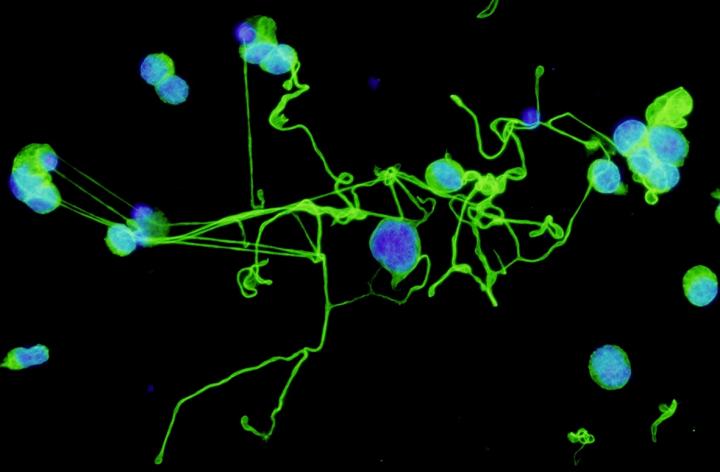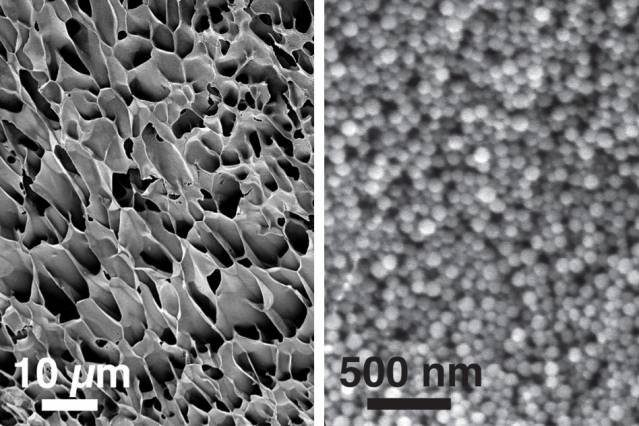
CREDIT
Courtesy Tufts University
Scalable model supports patient-specific treatments, advanced study of blood disorders
A team led by researchers at Tufts University School of Engineering and the University of Pavia has reported development of the first three-dimensional tissue system that reproduces the complex structure and physiology of human bone marrow and successfully generates functional human platelets. Using a biomaterial matrix of porous silk, the new system is capable of producing platelets for future clinical use and also provides a laboratory tissue system to advance study of blood platelet diseases.
“There are many diseases where platelet production or function is impaired,” says Alessandra Balduini, M.D., research associate professor in the Department of Biomedical Engineering at Tufts, associate professor at the Department of Molecular Medicine at the University of Pavia and co-corresponding author on the paper. “New insight into the formation of platelets would have a major impact on patients and healthcare. In this tissue system, we can culture patient-derived megakaryocytes — the bone marrow cells that make platelets — and also endothelial cells, which are found in bone marrow and promote platelet production, to design patient-specific drug administration regimes.”
The new system can also provide an in vitro laboratory tissue system with which to study mechanisms of blood disease and to predict efficacy of new drugs–providing a more precise and less costly alternative to in vivo animal models.
Read more: 3-D engineered bone marrow makes functioning platelets
The Latest on: 3D tissue system
[google_news title=”” keyword=”3D tissue system” num_posts=”10″ blurb_length=”0″ show_thumb=”left”]
via Google News
The Latest on: 3D tissue system
- I fear I’ve worked myself to death, admits Strictly’s Shirley Ballas after revealing ‘terrifying’ cancer scareon April 28, 2024 at 4:04 am
STRICTLY Come Dancing star Shirley Ballas today tells of her “terrifying” cancer scare after checks revealed lumpy tissue in her left breast. The head judge, 63, who has had three biopsies, said: ...
- Human mini-lungs mimic animal response to nanomaterialson April 27, 2024 at 5:05 am
Human mini-lungs grown by University of Manchester scientists can mimic the response of animals when exposed to certain nanomaterials.
- Daniel Ek’s Next Act: Full-Body Scans for the Peopleon April 27, 2024 at 5:00 am
The Spotify chief has co-founded a new start-up, Neko Health, that aims to make head-to-toe health scans part of the annual health checkup routine.
- A severed bicep, sick dog and more. Woman battles 6 life challenges amid breast canceron April 26, 2024 at 2:02 am
Life didn’t stop just because Emily was diagnosed with breast cancer. Six personal challenges aligned with each of her six chemotherapy treatments.
- Freeze casting—a guide to creating hierarchically structured materialson April 25, 2024 at 9:20 am
Freeze casting is an elegant, cost-effective manufacturing technique to produce highly porous materials with custom-designed hierarchical architectures, well-defined pore orientation, and ...
- Why animals run faster than their robot doppelgängers… for nowon April 24, 2024 at 11:00 am
“It [advances in robots] will move faster, because evolution is undirected,” University of Washington Department of Electrical & Computer Engineering Associate Professor Sam Burden said. “There are ...
- 3D Cell Culture Market is expected to reach revenue of USD 5.0 Bn by 2032, at 12.0% CAGR: Insights by Dimension Market Researchon April 23, 2024 at 8:25 am
Exploring the Dynamics of the 3D Cell Culture Market by an In-Depth Analysis of Growth Trajectories, Key Players, and Future TrendsNew Jersey, New York, Los Angeles, Austin, San Diego, Philadelphia, ...
- Study: Far-UVC light eliminates airborne virus in an occupied roomon April 22, 2024 at 3:02 am
Unlike conventional germicidal UVC light — which kills viruses and bacteria but can only typically be used in unoccupied rooms because direct exposure to it can potentially harm skin and eyes — ...
- Can aspirin help protect against colorectal cancers?on April 22, 2024 at 12:15 am
A new study details how a daily dose could prevent or delay the progression of the world’s third most common type of cancer.
- Researchers develop 3D imaging probe for cancer cell detectionon April 16, 2024 at 10:49 am
A research team at the University of Nottingham has developed an endoscopic probe enabling practitioners to three-dimensionally (3D) image the stiffness of individual biological cells and complex ...
via Bing News










